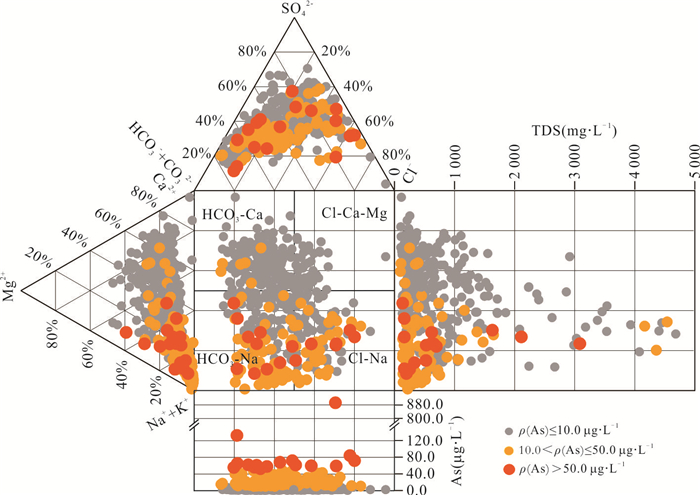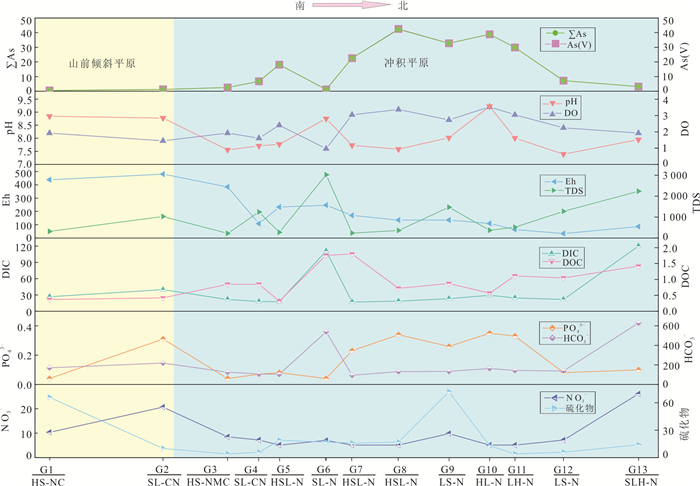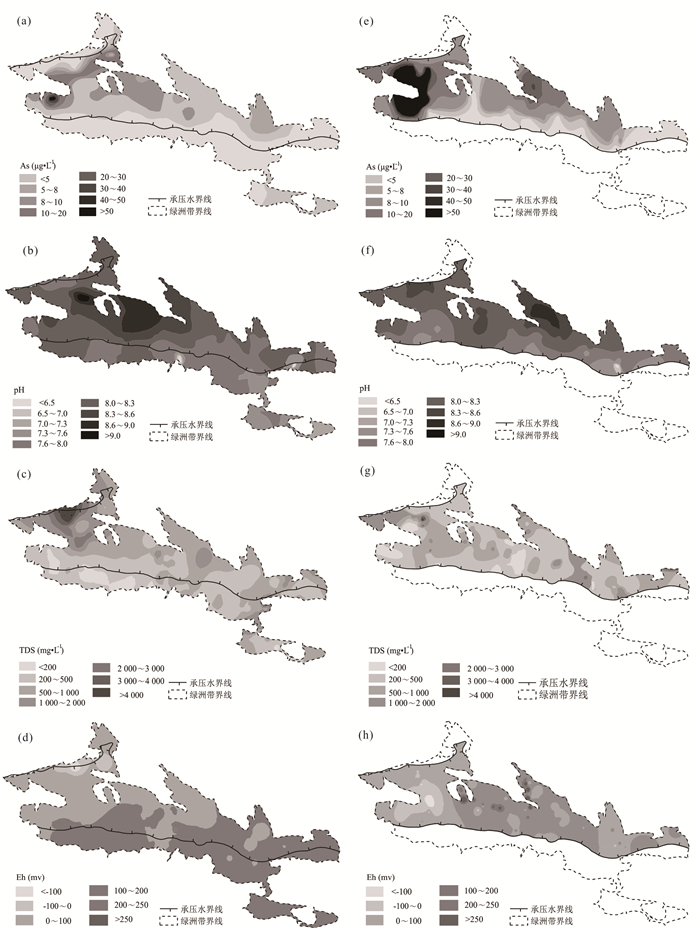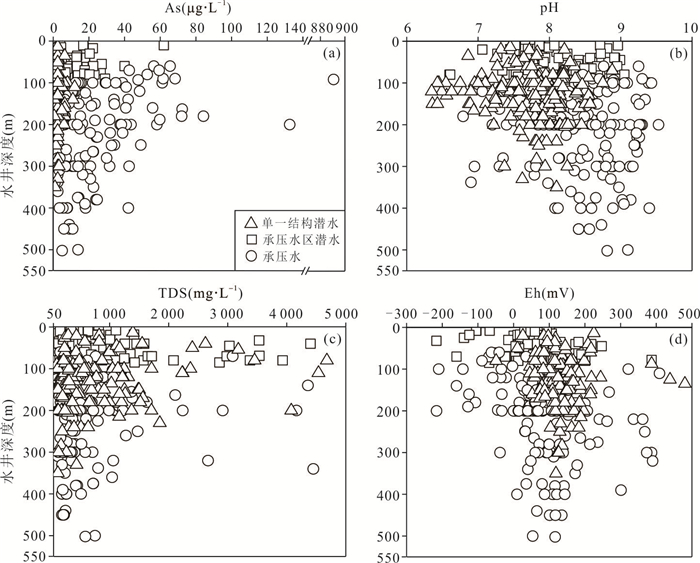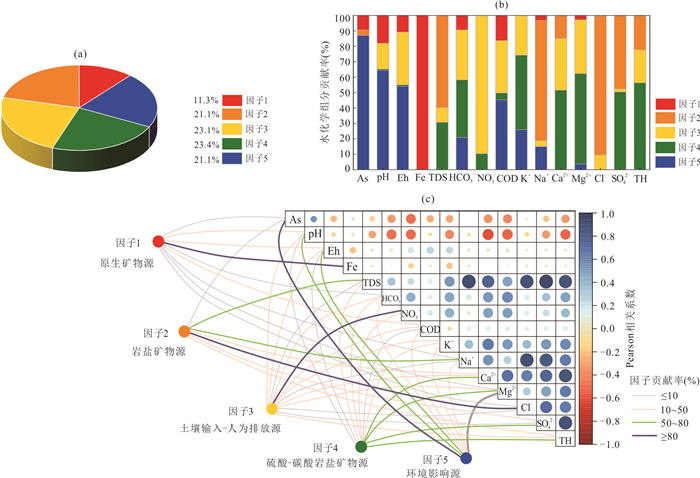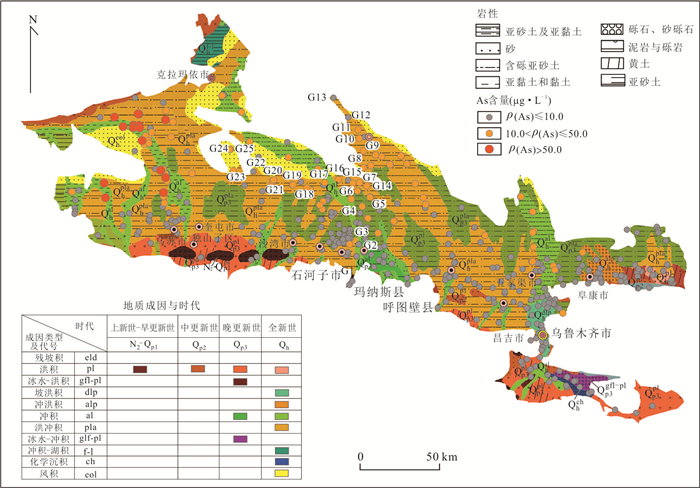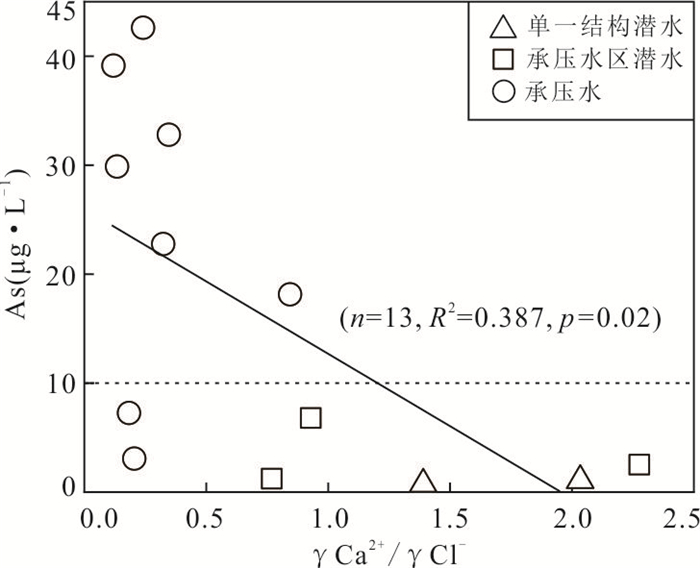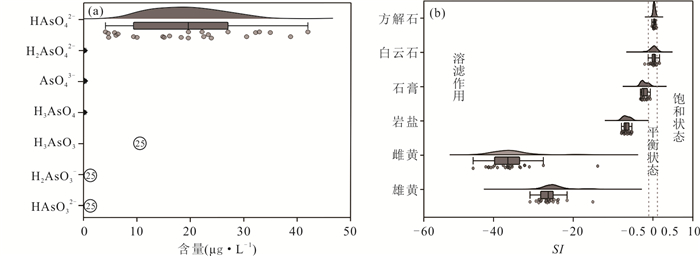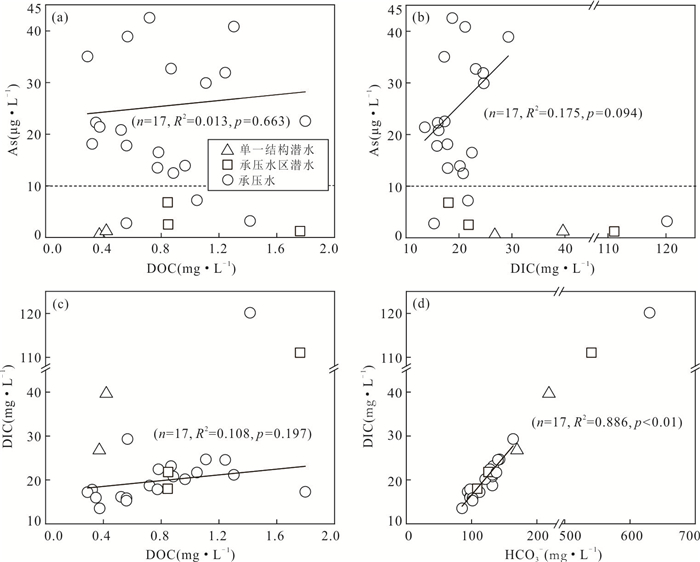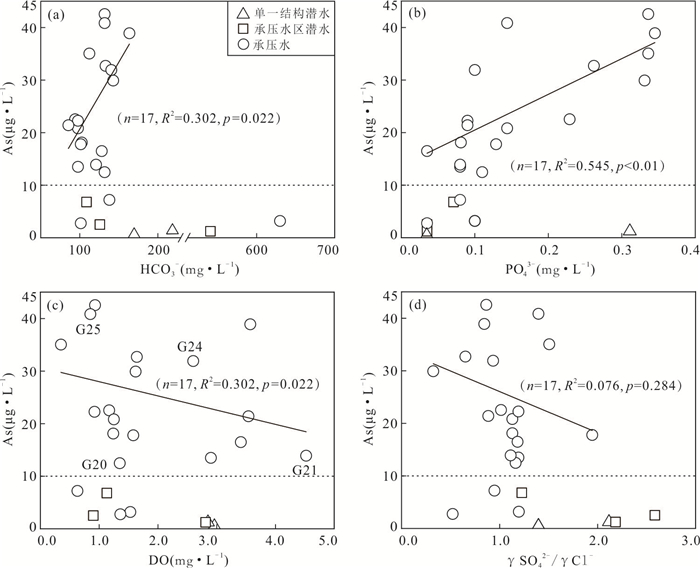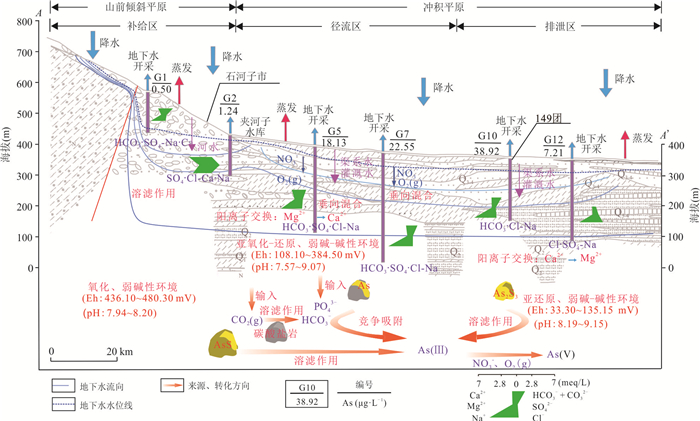Migration and Transformation Mechanism of High Arsenic Groundwater in Oasis Belt in Middle Part of Northern Piedmont of Tianshan Mountain
-
摘要: 准噶尔盆地是典型高砷地下水分布的内陆盆地,地下水作为盆地重要饮用水源,区域供水安全存在风险,高砷地下水迁移转化规律有待进一步查明. 以天山北麓中段绿洲带为研究区,采用半变异函数模型和UNMIX源解析模型分析该区地下水砷的分布、地下水化学组分源贡献;结合地质条件、赋存环境与水文地球化学作用剖析典型剖面高砷地下水中砷的迁移转化与富集影响因素. 结果表明:研究区地下水整体为弱碱性、偏还原环境的淡水,As含量在ND~887.0 μg·L-1之间,平均值为11.2 μg·L-1,ρ(As) > 10 μg·L-1的高砷地下水水化学类型以HCO3·SO4·Cl⁃Na(HSL⁃N型)和HCO3·SO4⁃Na(Na·Ca)型(HS-N(NC)型)为主. 单一结构潜水、承压水区潜水、承压水中高砷地下水占比分别为0.4%、6.4%、18.6%,高砷地下水主要富集于冲积平原深度100~300 m的承压含水层中. 原生矿物源、岩盐矿物源、土壤输入‒人为排放源、硫酸‒碳酸岩盐矿物源和环境影响源对地下水水化学组分贡献率分别为11.3%、21.1%、23.1%、23.4%和21.1%. 25组典型剖面地下水样中,24组地下水砷形态为As(Ⅴ)(占取样点的96.0%). 沿着地下水流向,从山前倾斜平原到冲积平原,地下水总As含量呈先增大后减小的变化趋势. 地下水砷富集不仅受到赋存环境中pH、Eh、HCO3-和PO43-等水化学指标的影响,还与地质条件、水文地质条件、有机质降解和溶滤作用等因素有关.Abstract: Junggar Basin is a typical inland basin with high arsenic groundwater distribution. Groundwater is an important drinking water source in the basin. Regional water supply safety is at risk. Migration and transformation of high arsenic groundwater need to be further investigated. In this study, the oasis belt in the middle part of the northern piedmont of Tianshan Mountain was taken as the research area. Semivariogram model and UNMIX source analysis model were used to analyze the distribution of arsenic in groundwater and the source contribution rate of groundwater chemical indexes, and influencing factors of arsenic migration. Transformation and enrichment in high arsenic groundwater in the typical profile were analyzed in combination with geological conditions, occurrence environment and hydrogeochemical action. Results show that groundwater in the study area is generally freshwater with weak alkaline and slightly reduced environment. Groundwater As concentration ranges between ND and 887.0 μg·L-1, with an average of 11.2 μg·L-1. Hydrochemical types of high arsenic groundwater (ρ (As) > 10 μg·L-1) are mainly HCO3·SO4·Cl⁃Na (HSL⁃N) and HCO3·SO4⁃Na (Na·Ca) (HS⁃N (NC)) types. Proportions of high arsenic groundwater in single-structure phreatic water, phreatic water in confined water area, and confined water are 0.4%, 6.4%, and 18.6%, respectively. Contribution rates of native mineral source, rock salt mineral source, soil input-human emission source, sulfuric-carbonate mineral source and environmental source to groundwater hydrochemical indexes are 11.3%, 21.1%, 23.1%, 23.4% and 21.1%, respectively. Arsenic species in 24 groups of a total of 25 groundwater samples of typical profiles is only As (Ⅴ) (96.0% of the sampling sites). From piedmont plain to alluvial plain, along groundwater flow, the variation trend of groundwater total arsenic concentration firstly increased and then decreased. Arsenic enrichment in occurrence environment is affected by groundwater hydrochemical indexes including pH, Eh, HCO3- and PO43-, which is also related to geological, hydrogeological conditions, organic matter degradation, and dissolution.
-
图 4 南北向典型剖面地下水中As与相关指标含量沿程变化
图中水化学指标pH为无量纲,∑As、As(Ⅴ)和硫化物单位为μg·L-1,Eh单位为mV,其余为mg·L-1;$ \frac{\mathrm{G}1}{\mathrm{H}\mathrm{S}\mathrm{-}\mathrm{N}\mathrm{C}} $表示$ \frac{\mathrm{编}\mathrm{号}}{\mathrm{水}\mathrm{化}\mathrm{学}\mathrm{类}\mathrm{型}} $;水化学类型中H、S、L、C、M和N分别表示HCO3、SO4、Cl、Ca、Mg和Na
Fig. 4. Variation of As and related index concentration in groundwater along the typical north-south profile
图 8 研究区第四纪地质图(改自王彩华, 2005)
Fig. 8. Quaternary geological map of the study area (modified from Wang, 2005)
表 1 典型剖面高砷与低砷地下水中的水化学指标对比
Table 1. Comparison of hydrochemistry indexes in high arsenic and low-arsenic groundwater in typical profiles
地下水As含量水平 特征值 ∑As As(Ⅲ) As(Ⅴ) pH DO Eh TDS DIC DOC PO43- HCO3- NO3- 硫化物 TFe 高砷地下水(n=17) 最小值 12.5 0 12.5 8.2 0.35 30.1 164.5 13.54 0.29 0.04 85.46 0.15 2.0 ND 最大值 42.6 14.8 42.3 9.2 4.52 319.0 1 474.7 29.33 1.80 0.35 163.60 4.88 72.0 0.07 平均值 25.4 0.9 24.5 8.7 1.97 160.2 484.9 19.81 0.79 0.17 117.59 0.60 20.0 0.06 低砷地下水(n=8) 最小值 0.5 0 0.5 7.6 0.63 33.3 220.7 15.28 0.37 0.04 101.33 2.08 4.0 ND 最大值 7.2 0 7.2 8.4 2.96 480.3 3 028.4 120.17 1.76 0.31 629.98 21.14 66.0 0.27 平均值 3.2 0 3.2 8.1 1.77 255.4 1 130.9 36.32 0.84 0.09 275.92 4.77 16.5 0.27 注:n为样本数;水化学指标中pH为无量纲,∑As、As(Ⅲ)、As(Ⅴ)和硫化物的单位为μg·L-1,Eh单位为mV,其余为mg·L-1. 表 2 地下水中As、pH和TDS半方差模型特征参数
Table 2. Characteristic parameters of As, pH and TDS semivariance model in groundwater
地下水类型 化学组分 理论模型 块金值C0 基台值C0+C 块金系数C0/(C0+C)(%) 变程(km) R2 RSS 潜水 As 球状模型 0.50 1.41 35.5 52.40 0.82 0.21 pH 指数模型 0.14 0.28 50.0 79.50 0.79 2.18×10-3 TDS 指数模型 3.0×10‒4 1.0×10‒3 30.0 51.90 0.76 1.39×10‒6 Eh 线性模型 6 515.11 6 515.11 100.0 90.28 0.69 1.35×107 承压水 As 高斯模型 0.02 0.03 66.7 70.84 0.83 7.95×10‒5 pH 指数模型 0.18 0.37 48.6 66.60 0.65 5.49×10‒3 TDS 指数模型 2.0×10‒4 3.85×10‒3 5.2 234.60 0.54 4.56×10‒9 Eh 指数模型 4 570 14 140 32.3 80.10 0.87 5.29×106 表 3 南北剖面不同地下水类型中砷和各指标含量统计
Table 3. Statistics of arsenic and index concentration in different groundwater types in the north-south section
地下水类型 地下水As含量水平 编号/特征值 ∑As As(Ⅲ) As(Ⅴ) pH DO Eh TDS DIC DOC PO43- HCO3- NO3- 硫化物 TFe 单一结构潜水 低砷地下水(n=2) G1 0.5 ND 0.5 8.2 2.96 438.6 316.0 26.76 0.37 0.04 170.00 5.38 66.0 ND G2 1.2 ND 1.2 7.9 2.85 480.3 1 029.3 39.64 0.42 0.31 218.54 15.75 10.0 ND 平均值 0.9 ND 0.9 8.1 2.91 459.5 672.7 33.20 0.40 0.18 194.27 10.57 38.0 ND 承压水区潜水 低砷地下水(n=3) 最小值 1.2 ND 1.2 7.6 0.90 108.1 220.7 18.00 0.85 0.04 108.66 2.08 4.0 ND 最大值 6.8 ND 6.8 8.2 2.81 384.5 3 028.4 111.08 1.76 0.07 540.85 3.50 17.0 0.27 平均值 3.5 ND 3.5 7.9 1.61 246.5 1 498.9 50.29 1.15 0.05 258.42 2.60 9.0 ND 承压水 低砷地下水(n=2) G12 7.2 ND 7.2 8.4 0.63 33.3 1 274.7 21.69 1.05 0.08 137.96 2.17 6.0 ND G13 3.2 ND 3.2 8.2 1.53 86.2 2 237.0 120.17 1.42 0.10 629.98 21.14 14.0 ND 平均值 5.2 ND 5.2 8.3 1.08 59.8 1 755.9 70.93 1.24 0.09 383.97 11.66 10.0 ND 高砷地下水(n=6) 最小值 29.9 ND 29.9 8.7 1.62 63.6 367.6 23.16 0.57 0.26 94.01 0.15 4.0 ND 最大值 38.9 ND 38.9 9.2 3.57 135.2 1 474.7 29.33 1.11 0.35 163.60 4.88 72.0 0.07 平均值 33.8 ND 33.8 8.9 2.28 103.0 787.9 25.72 0.85 0.31 127.99 1.73 23.5 ND 注:n为样本数;水化学指标中pH为无量纲,∑As、As(Ⅲ)、As(Ⅴ)和硫化物单位为μg·L-1,Eh单位为mV,其余为mg·L-1. 表 4 南北向剖面地下水反向水文地球化学模拟结果
Table 4. Reverse hydrogeochemical simulation results in groundwater of the north-south profile
矿物相 (单一结构潜水)G1→G2 (承压水)G5→G7 (承压水)G10→G12 方解石(CaCO3) 3.28×10‒4 ‒3.64×10‒4 ‒ 白云石(CaMg(CO3)2) 3.28×10‒4 1.41×10‒4 -6.36×10‒5 石膏(CaSO4·2H2O) 3.33×10‒3 -1.18×10‒4 2.41×10‒3 岩盐(NaCl) 3.18×10‒3 -1.96×10‒4 9.55×10‒3 雌黄(As2S3) -2.35×10‒6 -2.33×10‒7 4.85×10‒7 雄黄(AsS) 4.70×10‒6 5.25×10‒7 -1.39×10‒6 CO2(g) 3.63×10‒4 1.22×10‒4 -2.82×10‒3 NaX -1.53×10‒3 6.02×10‒4 1.27×10‒3 CaX2 - - -1.35×10‒3 MgX2 7.67×10‒4 -3.01×10‒4 7.17×10‒4 注:表中正值表示溶解,负值表示沉淀,“-”表示未参加反应. -
Abdelrady, A., Sharma, S., Sefelnasr, A., et al., 2020. Characterisation of the Impact of Dissolved Organic Matter on Iron, Manganese, and Arsenic Mobilisation during Bank Filtration. Journal of Environmental Management, 258: 110003. https://doi.org/10.1016/j.jenvman.2019.110003 An, F., Zhu, Y. F., 2009. Significance of Native Arsenic in the Baogutu Gold Deposit, Western Junggar, Xinjiang, NW China. Chinese Science Bulletin, 54(10): 1744-1749. https://doi.org/10.1007/s11434-009-0086-6 Cao, W. G., Yang, H. F., Gao, Y. Y., et al., 2020. Prediction of Groundwater Quality Evolution in the Baoding Plain of the SNWDP Benefited Regions. Journal of Hydraulic Engineering, 51(8): 924-935 (in Chinese with English abstract). Cao, Y. S., Guo, H. M., Ni, P., et al., 2017. Influences of Sediments Geochemical Characteristics and Land Utilization on Groundwater Arsenic Activities. Earth Science Frontiers, 24(2): 274-285 (in Chinese with English abstract). Chen, T. D., Chen, X. G., Wang, W. K., et al., 2009. Investigation and Evaluation of Groundwater Resources and Environmental Problems in Junggar Basin. Geological Publishing House, Beijing, 47-64 (in Chinese). Deng, Y. M., Wang, Y. X., Li, H. J., et al., 2015. Seasonal Variation of Arsenic Speciation in Shallow Groundwater from Endemic Arsenicosis Area in Jianghan Plain. Earth Science, 40(11): 1876-1886 (in Chinese with English abstract). Gao, Z. P., Jia, Y. F., Guo, H. M., et al., 2020. Quantifying Geochemical Processes of Arsenic Mobility in Groundwater from an Inland Basin Using a Reactive Transport Model. Water Resources Research, 56(2): e2019WR025492. https://doi.org/10.1029/2019WR025492 Gulgundi, M. S., Shetty, A., 2019. Source Apportionment of Groundwater Pollution Using Unmix and Positive Matrix Factorization. Environmental Processes, 6(2): 457-473. https://doi.org/10.1007/s40710-019-00373-y Guo, H. M., Ni, P., Jia, Y. F., et al., 2014. Types, Chemical Characteristics and Genesis of Geogenic High-Arsenic Groundwater in the World. Earth Science Frontiers, 21(4): 1-12 (in Chinese with English abstract). Guo, Q., Guo, H. M., Yang, Y. C., et al., 2014. Hydrogeochemical Contrasts between Low and High Arsenic Groundwater and Its Implications for Arsenic Mobilization in Shallow Aquifers of the Northern Yinchuan Basin, P. R. China. Journal of Hydrology, 518: 464-476. https://doi.org/10.1016/j.jhydrol.2014.06.026 Hong, L., 1983. A Preliminary Study on the Diseases and Formation Environment of High Fluoride and High Arsenic Water in Chepaizi Area, North Kuitun, Xinjiang. Environmental Protection of Xinjiang, 5(1): 22-28 (in Chinese). Hou, J., 2018. Research of Evolution of Groundwater Quality and Occurrence Mechanism of Trace Inorganic Components in Shihezi Area (Dissertation). Xinjiang Agricultural University, Urumqi (in Chinese with English abstract). Hug, S. J., Leupin, O. X., Berg, M., 2008. Bangladesh and Vietnam: Different Groundwater Compositions Require Different Approaches to Arsenic Mitigation. Environmental Science & Technology, 42(17): 6318-6323. https://doi.org/10.1021/es7028284 Hug, S. J., Winkel, L. H. E., Voegelin, A., et al., 2020. Arsenic and Other Geogenic Contaminants in Groundwater⁃A Global Challenge. Chimia, 74(7): 524-537. https://doi.org/10.2533/chimia.2020.524 Kuang, J., 2005. Palaeohighs and Targets for Petroleum Exploration in Junggar Basin. Xinjiang Petroleum Geology, 26(5): 502-509 (in Chinese with English abstract). doi: 10.3969/j.issn.1001-3873.2005.05.008 Lei, M., Zhou, J. L., Liang, X., et al., 2022. Hydrochemical Characteristics of Pore Water and Genesis of Soda Water in the Middle of the Northern Piedmont of Tianshan Mountain, Xinjiang. Earth Science, 47(2): 674-688 (in Chinese with English abstract). Liu, Y. B., 2018. Nitrate Distribution and Source Apportionment in Surface and Groundwater in Manas River Basin Oasis (Dissertation). Shihezi University, Shihezi (in Chinese with English abstract). Niu, S. Y., Sun, A. Q., Li, H. Y., et al., 2005. Evolution of Crust-Mantle and Its Eco-Environmental Effects in Zhangjiakou-Xuanhua Region. Earth Science Frontiers, 12(4): 597-606 (in Chinese with English abstract). doi: 10.3321/j.issn:1005-2321.2005.04.032 Pi, K. F., Wang, Y. X., Xie, X. J., et al., 2015. Geochemical Effects of Dissolved Organic Matter Biodegradation on Arsenic Transport in Groundwater Systems. Journal of Geochemical Exploration, 149: 8-21. https://doi.org/10.1016/j.gexplo.2014.11.005 Podgorski, J. E., Eqani, S., Khanam, T., et al., 2017. Extensive Arsenic Contamination in High-pH Unconfined Aquifers in the Indus Valley. Science Advances, 3(8): e1700935. https://doi.org/10.1126/sciadv.1700935 Román⁃Ross, G., Cuello, G. J., Turrillas, X., et al., 2006. Arsenite Sorption and Co-Precipitation with Calcite. Chemical Geology, 233(3-4): 328-336. https://doi.org/10.1016/j.chemgeo.2006.04.007 Schaefer, M. V., Guo, X. X., Gan, Y. Q., et al., 2017. Redox Controls on Arsenic Enrichment and Release from Aquifer Sediments in Central Yangtze River Basin. Geochimica et Cosmochimica Acta, 204: 104-119. https://doi.org/10.1016/j.gca.2017.01.035 Senn, D. B., Hemond, H. F., 2002. Nitrate Controls on Iron and Arsenic in an Urban Lake. Science, 296(5577): 2373-2376. https://doi.org/10.1126/science.1072402 Shaji, E., Santosh, M., Sarath, K. V., et al., 2021. Arsenic Contamination of Groundwater: A Global Synopsis with Focus on the Indian Peninsula. Geoscience Frontiers, 12(3): 101079. https://doi.org/10.1016/j.gsf.2020.08.015 Su, Y. P., Li, Q., Tao, H. F., et al., 2022. Factors Influencing the Abnormal Spatial Distribution of Arsenic Content in Groundwater in Kuitun River Basin. Journal of Yangtze River Scientific Research Institute, 39(2): 43-49, 55 (in Chinese with English abstract). Stolze, L., Zhang, D., Guo, H. M., et al., 2019. Surface Complexation Modeling of Arsenic Mobilization from Goethite: Interpretation of an In-Situ Experiment. Geochimica et Cosmochimica Acta, 248: 274-288. https://doi.org/10.1016/j.gca.2019.01.008 Sø, H. U., Postma, D., Hoang, V. H., et al., 2018. Arsenite Adsorption Controlled by the Iron Oxide Content of Holocene Red River Aquifer Sediment. Geochimica et Cosmochimica Acta, 239: 61-73. https://doi.org/10.1016/j.gca.2018.07.026 Wallis, I., Prommer, H., Berg, M., et al., 2020. The River-Groundwater Interface as a Hotspot for Arsenic Release. Nature Geoscience, 13(4): 288-295. https://doi.org/10.1038/s41561-020-0557-6 Wang, C. H., 2005. Environmental Geology Atlas of Xinjiang Uygur Autonomous Region. Changji Xinjiang Gold Plate Printing Co. Ltd., Changji, 13 (in Chinese). Wang, J. J., Liang, X., Liu, Y. F., et al., 2019. Hydrogeochemical Evolution along Groundwater Flow Paths in the Manas River Basin, Northwest China. Ground Water, 57(4): 575-589. https://doi.org/10.1111/gwat.12829 Wen, D. G., Zhang, F. C., Zhang, E. Y., et al., 2013. Arsenic, Fluoride and Iodine in Groundwater of China. Journal of Geochemical Exploration, 135: 1-21. https://doi.org/10.1016/j.gexplo.2013.10.012 WHO (World Health Organization), 2011. Guidelines for Drinking-Water Quality. WHO, Geneva, 541. Yu, G. Q., Sun, D. J., Zheng, Y., 2007. Health Effects of Exposure to Natural Arsenic in Groundwater and Coal in China: An Overview of Occurrence. Environmental Health Perspectives, 115(4): 636-642. https://doi.org/10.1289/ehp.9268 Zhang, H. Y., Zhang, X. J., Liu, W. B., et al., 2022. Impacts of Active Tectonics on Geogenic Arsenic Enrichment in Groundwater in the Hetao Plain, Inner Mongolia. Quaternary Science Reviews, 278: 107343. https://doi.org/10.1016/j.quascirev.2021.107343 Zhang, J., Liang, X., Liu, Y. F., et al., 2022. The Collaborative Kriging Method Based on Principal Components to Predict the Spatial Distribution of Arsenic in Groundwater. Earth Science, 48(10): 3820-3831 (in Chinese with English abstract). Zhang, R. Q., Liang, X., Jin, M. G., et al., 2018. Fundamentals of Hydrogeology. Geological Publishing House, Beijing, 57 (in Chinese). Zheng, M. L., Fan, X. D., He, W. J., et al., 2019. Superposition of Deep Geological Structural Evolution and Hydrocarbon Accumulation in the Junggar Basin. Earth Science Frontiers, 26(1): 22-32 (in Chinese with English abstract). Zhou, B. B., Guo, J., Chen, X. P., et al., 2021. Source Apportionment of Soil Heavy Metals in Abandoned Mining Areas in Dafan Mountain of Anhui Province Based on the UNMIX Model. Transactions of the Chinese Society of Agricultural Engineering, 37(24): 240-248 (in Chinese with English abstract). Zhou, Y. Z., 2018. Biogeochemical Processes in High Arsenic Groundwater in the Northwestern Hetao Basin, Inner Mongolia: Evidences from Hydrogeochemistry and Stable Isotopes (Dissertation). China University of Geosciences, Beijing (in Chinese with English abstract). Zhou, Y. Z., Zeng, Y. Y., Zhou, J. L., et al., 2017. Distribution of Groundwater Arsenic in Xinjiang, P. R. China. Applied Geochemistry, 77: 116-125. https://doi.org/10.1016/j.apgeochem.2016.09.005 曹文庚, 杨会峰, 高媛媛, 等, 2020. 南水北调中线受水区保定平原地下水质量演变预测研究. 水利学报, 51(8): 924-935. 曹永生, 郭华明, 倪萍, 等, 2017. 沉积物地球化学特征和土地利用方式对地下水砷行为的影响. 地学前缘, 24(2): 274-285. 谌天德, 陈旭光, 王文科, 等, 2009. 准噶尔盆地地下水资源及其环境问题调查评价. 北京: 地质出版社, 47-64. 邓娅敏, 王焰新, 李慧娟, 等, 2015. 江汉平原砷中毒病区地下水砷形态季节性变化特征. 地球科学, 40(11): 1876-1886. doi: 10.3799/dqkx.2015.168 郭华明, 倪萍, 贾永锋, 等, 2014. 原生高砷地下水的类型、化学特征及成因. 地学前缘, 21(4): 1-12. 洪里, 1983. 新疆奎屯北部车排子地区高氟、高砷水的病害与形成环境的初步研究. 新疆环境保护, 5(1): 22-28. 侯珺, 2018. 石河子地区地下水水质演化与微量无机组分形成机理研究(博士学位论文). 乌鲁木齐: 新疆农业大学. 况军, 2005. 准噶尔盆地古隆起与油气勘探方向. 新疆石油地质, 26(5): 502-509. 雷米, 周金龙, 梁杏, 等, 2022. 新疆天山北麓中段孔隙水水化学特征及苏打水的成因. 地球科学, 47(2): 674-688. doi: 10.3799/dqkx.2021.027 刘一博, 2018. 玛纳斯河流域绿洲区地表、地下水硝酸盐分布规律与源解析(硕士学位论文). 石河子: 石河子大学. 牛树银, 孙爱群, 李红阳, 等, 2005. 张宣地区壳幔演化与生态效应. 地学前缘, 12(4): 597-606. 宿彦鹏, 李巧, 陶洪飞, 等, 2022. 奎屯河流域高砷地下水砷含量空间分布异常的影响因素. 长江科学院院报, 39(2): 43-49, 55. 王彩华, 2005. 新疆维吾尔自治区环境地质图集. 昌吉: 昌吉新疆金版印务有限公司, 13. 张洁, 梁杏, 刘延锋, 等, 2022. 基于主成分的协克里金法对地下水砷空间分布预测. 地球科学, 48(10): 3820-3831. doi: 10.3799/dqkx.2021.180 张人权, 梁杏, 靳孟贵, 等, 2018. 水文地质学基础. 北京: 地质出版社, 57. 郑孟林, 樊向东, 何文军, 等, 2019. 准噶尔盆地深层地质结构叠加演变与油气赋存. 地学前缘, 26(1): 22-32. 周蓓蓓, 郭江, 陈晓鹏, 等, 2021. 基于UNMIX模型的安徽大矾山废弃矿区土壤重金属源解析. 农业工程学报, 37(24): 240-248. 周殷竹, 2018. 基于碳、铁稳定同位素的高砷地下水生物地球化学研究(博士学位论文). 北京: 中国地质大学. -










 下载:
下载:
